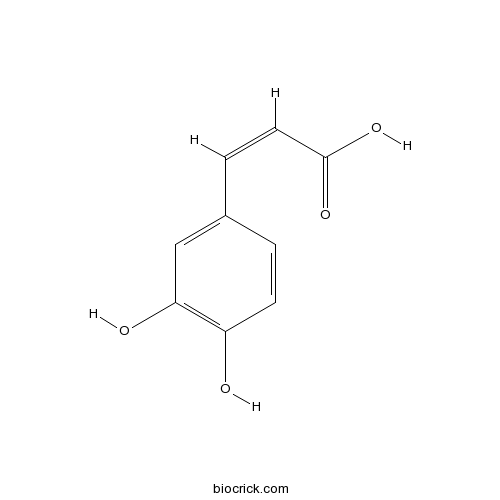Petasites japonicus
Petasites japonicus
1. The products in our compound library are selected from thousands of unique natural products; 2. It has the characteristics of diverse structure, diverse sources and wide coverage of activities; 3. Provide information on the activity of products from major journals, patents and research reports around the world, providing theoretical direction and research basis for further research and screening; 4. Free combination according to the type, source, target and disease of natural product; 5. The compound powder is placed in a covered tube and then discharged into a 10 x 10 cryostat; 6. Transport in ice pack or dry ice pack. Please store it at -20 °C as soon as possible after receiving the product, and use it as soon as possible after opening.
Natural products/compounds from Petasites japonicus
- Cat.No. Product Name CAS Number COA
-
BCN5979
Caffeic acid331-39-5
Instructions

AMPK/Nrf2 signaling is involved in the anti-neuroinflammatory action of Petatewalide B from Petasites japonicus against lipopolysaccharides in microglia.[Pubmed: 29433360]
Abnormal microglia secrete neuroinflammatory factors that play a pivotal role in neurodegenerative-disorder development. Thus, regulating abnormal microglia-activation could be a promising therapeutic strategy. The purposes of this study included investigating the effect of Petatewalide B on lipopolysaccharide- (LPS-) stimulated microglia and exploring the role of the AMPK/Nrf2- (adenosine monophosphate-activated protein kinase/nuclear factor erythroid 2-related factor 2) signaling pathway in the anti-neuroinflammatory function of Petatewalide B.
Petasites japonicus bakkenolide B inhibits lipopolysaccharide‑induced pro‑inflammatory cytokines via AMPK/Nrf2 induction in microglia.[Pubmed: 29286084]
Abnormal neuroinflammatory responses have diverse roles in neuronal death, oxidative stress and neurodegenerative diseases, such as Alzheimer's and Parkinson's disease. Microglia regulate these responses via molecular signaling cascades that involve inflammatory cytokines and complement proteins. Bakkenolide B from Petasites japonicus exhibits significant anti‑inflammatory and anti‑allergic bioactivities. The present study investigated the anti‑neuroinflammatory effects and underlying molecular mechanisms of bakkenolide B on the lipopolysaccharide (LPS)‑mediated neuroinflammatory response in microglia. The results indicated that bakkenolide B pretreatment significantly reduced microglial production of interleukin (IL)‑1β, IL‑6, IL‑12, and tumor necrosis factor (TNF)‑α. Furthermore, this effect was associated with reduced production of reactive oxygen species. The role of bakkenolide B was then evaluated in the upregulation of nuclear factor erythroid 2‑related factor 2 (Nrf2)/antioxidant response element (ARE) signaling pathways. The results suggested that bakkenolide B significantly upregulated Nrf2/ARE pathway‑related downstream factors, such as NADPH dehydrogenase quinone‑1 (NQO‑1) and heme oxygenase‑1 (HO‑1). Silencing of Nrf2, HO‑1 and NQO‑1 diminished the anti‑neuroinflammatory properties of bakkenolide B. AMP‑activated protein kinase (AMPK) activates the Nrf2/ARE signaling pathway, and the results of the present study demonstrated that bakkenolide B increased AMPK phosphorylation in microglia. In addition, an AMPK inhibitor abolished the bakkenolide B‑induced increase in nuclear Nrf2, NQO‑1 and HO‑1 protein expression. Finally, an AMPK inhibitor diminished the bakkenolide B‑mediated inhibition of LPS‑stimulated TNF‑α production. Taken together, the present results demonstrate that bakkenolide B may be an effective and therapeutically relevant AMPK/Nrf2 pathway activator for suppressing abnormal neuro-inflammation in neurodegenerative diseases.
LC-MS/MS characterization, anti-inflammatory effects and antioxidant activities of polyphenols from different tissues of Korean Petasites japonicus (Meowi).[Pubmed: 28623844]
None
Dual Protective Effects of Flavonoids from Petasites japonicus against UVB-Induced Apoptosis Mediated via HSF-1 Activated Heat Shock Proteins and Nrf2-Activated Heme Oxygenase-1 Pathways.[Pubmed: 28566621]
The leaves of Petasites japonicus are used for their anti-allergic properties in traditional Korean, Japanese, and Chinese medicine. This study aimed to identify bioactive compounds isolated from P. japonicus leaves. All compounds were assessed for their ability of transcriptional activation, induction of phase 2 enzymes and heat shock proteins (HSPs), as well as protection against the UVB-induced apoptotic cell death. Bioactive compounds were isolated from P. japonicus leaves. All compounds were evaluated for their protective effect using human dermal fibroblasts (HDF) and human epidermal keratinocyte cells (HEKC) treated with UVB radiation. Four flavonoids were isolated from the leaves of P. japonicus and identified as kaempferol-3-O-(6″-acetyl)-β-D-glucoside (1), quercetin-3-O-(6″-acetyl)-β-D-glucoside (2), kaempferol-3-O-β-D-glucoside (3), and quercetin-3-O-β-D-glucoside (4). These compounds activated nuclear factor (erythroid-derived 2)-like 2 (Nrf2) and heat-shock response transcription elements (HSE) that resulted in the induction of heme oxygenase-1 (HO-1) and HSP70, respectively. Activation of these pathways provided protection to the skin cells against UVB radiation. The isolated compounds activated the Nrf2 and HSE pathways and could protect against UVB-induced apoptosis.
Petatewalide B, a novel compound from Petasites japonicus with anti-allergic activity.[Pubmed: 26674157]
The giant butterbur Petasites japonicus is used to treat asthma and allergic diseases in traditional Korean, Japanese, and Chinese medicine.
Petasites japonicus Stimulates the Proliferation of Mouse Spermatogonial Stem Cells.[Pubmed: 26207817]
Oriental natural plants have been used as medical herbs for the treatment of various diseases for over 2,000 years. In this study, we evaluated the effect of several natural plants on the preservation of male fertility by assessing the ability of plant extracts to stimulate spermatogonial stem cell (SSC) proliferation by using a serum-free culture method. In vitro assays showed that Petasites japonicus extracts, especially the butanol fraction, have a significant effect on germ cells proliferation including SSCs. The activity of SSCs cultured in the presence of the Petasites japonicus butanol fraction was confirmed by normal colony formation and spermatogenesis following germ cell transplantation of the treated SSCs. Our findings could lead to the discovery of novel factors that activate SSCs and could be useful for the development of technologies for the prevention of male infertility.


